The American lighthouses of the Thousand Islands have fared better than their Canadian counterparts over the years. Of the seven that were built in the nineteenth century, all have survived to the present – although one of these has been moved inland as a tourism landmark.
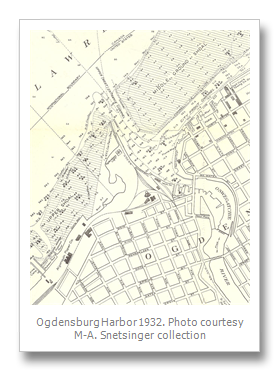
The Ogdensburg Harbor light is one of the oldest lighthouses in the Thousand Islands, and the furthest east of the American ones. It was built in 1834, where the Oswegatchie River empties into the St. Lawrence, and helped boats navigate cross-currents between the Upper Shoal and Middle Ground Shoal that crowd the channel into the river. Only Tibbett’s Point lighthouse, near Cape Vincent, New York (1827) is older. Windmill Point lighthouse (located 1.8 miles northeast of Ogdensburg across the river in Prescott, Ontario) is the furthest east of the Thousand Islands lighthouses; while technically older than the Ogdensburg Harbor light (the tower was built in 1832), it was not until 1872 that it was retrofitted for use as a lighthouse.
Like many of the lighthouses of the Thousand Islands, the Ogdensburg Harbor light has gone through modifications that have changed its appearance significantly, but its strategic location has remained the same. The original structure, for which Congress spent $5,000, was built on one and a half acres of land, and consisted of a keeper’s dwelling and a lantern room. It was lighted with ten lamps and reflectors, placed in a circular arrangement. W. H. Bartlett, from his third tour of North America in 1841, provides us with an early image of the lighthouse.
The first lightkeeper at Ogdensburg Harbor was Amos Wells. He kept the lights for sixteen years, from 1835 to 1851, when he resigned. He was followed by a series of other keepers, about most of whom equally little is known:
|
Luman Newell
|
1851 to 1854
|
Resigned
|
|
William Gardner
|
1854 to 1861
|
Resigned
|
|
Talman Smith
|
1861 to 1867
|
Resigned
|
|
Samuel Sayre
|
1867 to 1869
|
Removed
|
|
James Horton
|
1869 to 1871
|
Removed
|
|
John Ross
|
1871 to 1871
|
Resigned
|
|
Lewis Young
|
1871 to 1888
|
Resigned
|
|
Samuel Penfield
|
1888 to 1913
|
Resigned
|
|
Amherst Gunn
|
1913 to 1932
|
Retired
|
|
Daniel Hill
|
1932 to 1933
|
Transferred
|
Eventually a fire caused extensive damage to the lighthouse, and in the summer of 1870 Congress provided $13,000 for the “renovation and repair” that appears to have been the construction of a new lighthouse. While sources are not specific with respect to the nature of the first lighthouse, the Bartlett engraving suggests a frame structure, and there are references to “repairs” as early as 1838, and to a “white” tower; more convincingly, the Lists of Lights abruptly and consistently refer to the “limestone” of the lighthouse beginning in 1871. This limestone structure was the basis for the lighthouse that we see today. The stone used for its construction was quarried in Kingston, Ontario. The result was a solid stone dwelling house with an attached stone tower of 39 feet, eight inches in height. Perhaps it is a coincidence, but the undoubted disruption during the building may explain the short-term changes of the keeper in 1871.
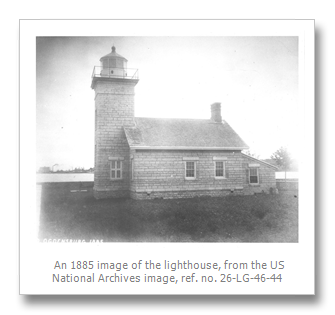
It was during the tenure of Lewis Young, in 1875, that the fuel used to power the lights was switched from whale oil to kerosene. The Canadian lighthouses of the Thousand Islands, in contrast, had already been using kerosene for over a decade. The Canadian lights were initially fuelled by oil from Sperm Whales, but by the mid-1800s, it was a commodity already becoming scarce as whale populations declined. By 1860 the government had experimented with coal oils, which they deemed to have “. . . equal, if not superior illuminating qualities – do not burn away so fast as sperm [oil], and their cost is little more than one half of that of the latter.” After retrofitting the burners to support this fuel during the preceding fall, the Canadian lighthouses were switched to kerosene in 1861.
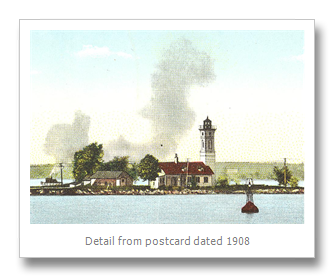
Lewis Young was paid $500 per annum in 1885 and 1887. Salaries for light-keepers in the American Thousand Islands at this time varied from $480 to $560. Interestingly, the remuneration appears to be significantly better than what the keepers north of the border received. During the same years, salaries for light-keepers in the Canadian Thousand Islands varied from $150 to $480, and the only two keepers who received more than $250 per annum were each in charge of two lighthouses.
Improvement to the Ogdensburg Harbor light’s visibility was the impetus behind the 1900 rebuild, during which the tower of the lighthouse was heightened to 65 feet. Sometime between its construction in 1870 and the tower modification in 1900, perhaps during that rebuild, two gabled dormers were also added to the sloped roof of the dwelling.
The brickwork of the tower extension was covered by a gray concrete-like material by 1920, perhaps to improve its resistance to the elements and give the tower a more uniform appearance, but covering the lower-level window detailing. This aesthetic downgrade was particularly notable in the lower half of the extension, where the decorative detailing of the brickwork around windows on some faces and suggestive of windows on others was hidden by the covering.
The longest serving lightkeeper at Ogdensburg Harbor was Samuel Penfield, who served for 25 years. He was followed by Amherst Gunn, during whose tenure the light was converted from kerosene to electricity (around 1924). A comparison to the Canadian side of the river is again of interest. Aside from a period during which the lighthouses were switched to acetylene as a fuel (1904 to 1912), the Canadian lighthouses of the region continued to use kerosene much longer, and the conversion to electricity did not take place until the mid-1940s.
Daniel Hill came from Crossover Lighthouse at the beginning of 1932 to take charge of the Ogdensburg Harbor lighthouse. According to most records and to a postcard signed by his son Roger Hill, he was transferred to Huron, Ohio, at the west end of Lake Erie, in November 1933, when the light was discontinued. A few sources, however, suggest that there was further life at the lighthouse, during which Harold Cook acted as keeper until 1942, when the lighthouse was automated. Support for this continuation is found in a Coast Guard image from 1940, which labels the structure the Ogdensburg Light Station. It may be that the lightkeeper was a Coast Guard employee with duties other than solely caring for the lighthouse.
Following World War II, the lighthouse was used for residential purposes, but it was not until 1964 that the light was discontinued, and the government sold the property to the private landowners, in whose family it remains. The lighthouse has found a new life under their guardianship, and the family made extensive renovations after their purchase to rehabilitate the lighthouse for use as a summer home. The structure is much the same, except that the two gabled dormers have been altered to create a wider, four-window dormer on each side of the roof.
Outrage erupted in Ogdensburg in 2007, when Blair Roethel – son of the original private owners – made application to the City of Ogdensburg to demolish the lighthouse. City officials contacted the Department of Environmental Conservation to find ways to save the lighthouse. Eventually the application was denied as it failed to include a plan for asbestos removal and structural reviews.
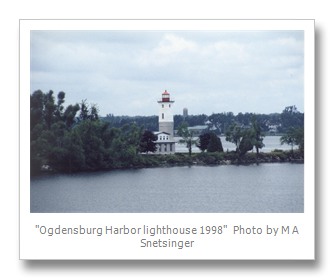
The application, it turned out, was a strategic move by Mr. Roethel to draw attention to the high taxes and fees he paid, as a private citizen, to maintain a structure that was of historical value and a tourist attraction. The media attention allowed the Roethel family to build links with charitable foundations and other groups interested in helping to maintain the lighthouse. Just last year the family was successful in gaining permission from the U.S. Coast Guard to re-light Ogdensburg Harbor as a private aid to navigation. In October 2011 it was re-lit, realizing the first Mr. Roethel’s dream. Thus, the 2012 List of Lights once again includes Ogdensburg Harbor, light number 992, as a private aid to navigation.
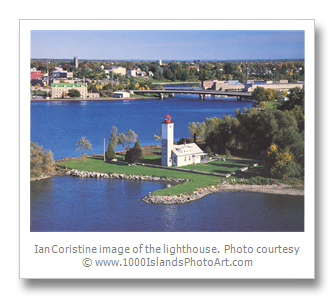
Acknowledgements: The author would like to acknowledge with appreciation the information compiled and provided by Thomas Tag on lightkeepers at Ogdensburg Harbor and other American lighthouses of the Thousand Islands. As well, she thanks Ian Coristine for permission to use his aerial photograph of the lighthouse.
By Mary Alice Snetsinger, ecoserv@kos.net
Mary Alice Snetsinger is a conservation biologist now working in Kingston. She grew up in the United States and Canada, and worked for four years at St. Lawrence Islands National Park. She became interested in the 19th century lighthouses of the Thousand Islands in 1997, and has researching them ever since. In November 2009, Mary Alice provided TI Life with Wolfe Island’s Lighthouses and Fiddler's Elbow and Lindoe Island Lights, in June 2010.
Mary Alice would welcome hearing from any reader with more images or stories of the Ogdensburg or other Thousand Islands lighthouses.